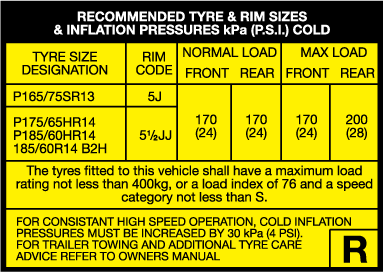
Wheels and tyres are vital to your safety. Since 1971, strict design standards (ADR 24) have been progressively introduced to specify wheel rims that will stop a deflated tyre from coming off the wheel, to specify strength, air pressures, speed ratings and allowable combinations of wheel and tyre sizes.
From 1973 all cars have been fitted with a tyre placard (usually located inside the driver's door, glove box of fuel filler cap) which specifies the wheel and tyre combinations recommended by the vehicle manufacturer. The placard also specifies recommended air pressure, load capacity and speed rating of tyres.
Every passenger car manufactured after 1972 (ADR 24) is fitted with a tyre placard containing information on original and optional tyres and rims for that vechicle model.

A motor vehicle under 4.5 tonnes, which is required to comply to ADR 24, may be equipped with tyres often than those listed on the tyre placard provided that:
- the load rating of the tyres is not less than the lowest load rating listed on the tyre placard on the vehicle or equivalent variant of that model vechicle;
- the speed rating of the tyres fitted to a passenger vehicle is at least 180 km/h (''S') when the tyre placard requires a higher speed rating than "S",
- the speed rating of the tyres fitted to vehicles with special features for off-road use of at least 140km/h ("N") when the tyre placard requires a higher speed rating that "N", and;
- for all other vehicles a speed rating of at least 120km/h
In special circumstances, the speed rating may be less than the ratings specified above if the speed rating of the tyre is more than the vehicle's maximum speed.
Where a vehicle has its GVM re-lated, the tyre load capacity must be capable of carrying the revised GVM, both in total and across individual axles.
Replacement tyres must also conform with the following requirements:
- the tyres are rated by the tyre manufacturer as being suitable for road use,
- the tyre construction (e.g. radial) and size must be the same on each axle; and
- where retreaded tyres are used, they must have been retreaded and marked in accordance with the provisions of Australian Standard AS 1973 - 1993 Pneumatic Tyres - Passenger Car, Light Truck and Truck/Bus - Retreading and Repair Processes.
The tyre placard contains essential information about the correct tyre use for your vehicle. The placard includes recommended tyre sizes and correct inflation pressures for your front and rear tyres under usual driving conditions after purchase from the factory in its ‘original’ condition.
- You can usually find your tyre placard in or around your vehicle:
- Your vehicle’s glove box
- In the driver’s side door
- Inside the fuel cap
- Under the bonnet of the vehicle
While most tyre placards contain similar information, like the correct tyre used for your vehicle, tyre placards can differ for different types of cars.
4WDs often have two placards containing information for two different types of tyre fitment - passenger and light truck (LT). The tyre placard will usually state different pressure recommendations depending on the tyre size and the load the vehicle carries; the higher the load, the higher the tyre pressure.
For example, 4WD utes may be running at 32 PSI on all four tyres when the vehicle has no load. However, the recommended tyre pressure can change to 32PSI upfront and 36 PSI in the rear when laden.
While tyre placards may differ in make, model and type of vehicle, due to their unique requirements, the fitments will usually contain similar information about tyres. All will signify the correct tyre size, their relationship to rims, the correct tyre pressure for typical driving conditions, and the all-important load ratings.
Tyre placards can be a bit confusing when you first look at them. It probably doesn’t help that they all look slightly different depending on your vehicle type, make and model. However, the information on the tyre placard is a more detailed version of the code written on your tyre sidewall.
While tyre placards are often set out slightly different from each other, each tyre placard contains similar information as the other.
The placard’s headline reminds us what the overall aim of the information is, for example, Recommended Tyre and Rim Sizes and Inflation Pressures kPA (Psi) Cold.
The placard will then show specific information relating to the vehicle, generally under the following categories:
- Tyre Size Designation: It is likely to list at least two specifications of tyres, showing the original tyre size and a few other alternatives. You can see if your current tyres are the original size by comparing the tyre placard to the code etched onto your current vehicle’s tyres.
- Rim Code: for example, on a rim code 6j, your wheels are 6” wide, and the J indicates the shape of the wheel on the place where the tyre bead sits on the wheel.
- Pressure for Normal Load: This will show the correct pressure for the tyres originally fitted to the car. The pressure is represented in Kilopascals (kPa) and pounds per square inch (PSI). The conversion is 7kPa = 1 PSI.
- Pressure for Maximum Load: This is shown for both front and rear. Only inflate your tyres to the maximum numbers shown on the placard. To get an accurate tyre pressure reading check them with a pressure gauge before you drive so that they are cold. You should not laden your vehicle more than the maximum load. This can differ from the front or back tyres.
- Minimum Load Index: Represented by a numerical value e.g. 98, which would refer to a load capacity of 750kgs.
- Speed Rating: This is often represented by a letter associated with the tyre’s maximum speed. You can also find the speed rating on your tyre.
Additional loads (such as towing): If you’re carrying an increased load or driving at high speed, it’s good to increase your tyre pressure. On the placard, it will denote the maximum pressure. If not, it will likely refer you to the vehicle owner’s manual for more details.
The short answer is yes.
Since 1973 tyre placards have been a legal requirement and they come fitted in all new passenger, 4×4 and light truck vehicles.
The tyre placard provides essential recommended information that is vital for safety reasons. Their display data includes information on tyre pressures, load capacity and speed rating. The tyre placard also provides information on the original and optional tyres and rims for that vehicle model.
Although it is recommended that the speed index also meets that of the original tyres on the placard, this is not a legal requirement and minimum speed indexes are covered by state legislation.
It’s important that the inflation pressures for the tyres are correct at all times and any new tyre fitted to a vehicle must also meet the relevant minimum load index. This is especially important if that tyre differs from the original fitted by the manufacturer.
All this vital information appears on the very useful tyre placard. Luckily, your tyre placard is often in various places around your car. You’ll often be able to find it on the panel on the inside of the driver’s car, in your glove box, inside the fuel cover, or sometimes under the bonnet of your vehicle. Their prominent position on your vehicle means it’s pretty hard to lose.
We’ve matched your registration number Sorry, we couldn’t find a match for registration number !
- Wheels
- Services & Repairs
-
Tyres
- Shop the Best Electric Vehicle Tyres: Upgrade Your Ride
- Snow tyres in Australia?
- Snow chains | Jax Tyres
- Buy Performance & Semi Slick Tyres
- Buy Light Truck & Commercial Tyres
- Buy Trailer & Caravan Tyres
- Buy All-Terrain, Off-Road & Mud Tyres
- Buy 4WD & SUV Tyres
- Tyre Pricing
- My Jax Platinum
- ECE 30 & 54 Regulations
- Uniform Tyre Grading System
- Tyre Inflation Pressures
- How to Understand Tyre Speed Rating
- Trailer & Caravan Tyres
- 4WD Driving Tips
- Plus One Tyre Sizing: Learn How To Plus Size Tyres & Wheels
- Tyre Choice
- Legal Tips
- Mercedes Original Equipment Extended Mobility (MOE) Markings
- Tyre Talk - What Do the Numbers Mean?
- What is tyre rotation?
- Understanding Tyre Load Rating
- Tyre Placard
- Tyre Examination & Repair
- When fitting just two tyres
- Tyre Repair Services
- Tyres and Wheels
- Second Hand Tyres
- Bald Tyres
- TPMS
- Run Flat Tyres
- Your guide to space saver tyres
- How to Change a Tyre
- Light Truck Tyres vs Commercial
- Low Profile Tyres
- Gearboxes explained
- Tyre Slime explained

